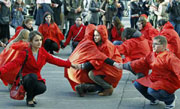-
(单词翻译:双击或拖选)
Struggle Against AIDS Makes Progress But More Gains Needed
As communities around the globe mark World AIDS Day December 1, HIV infection rates in some parts of the world are surging, and remaining "stubbornly steady" in many other regions. At the same time, more effective prevention strategies and progress toward an HIV vaccine1 are generating new hope for what U.S. Secretary of State Hillary Clinton recently called "an AIDS-free generation."
“The goal of an AIDS-free generation may be ambitious, but it is possible,” said Clinton.
Speaking at a Washington forum2, she called on global health experts, scientists, and advocates to redouble their efforts.
The stakes are high. AIDS - a disease associated with the Human Immuno-deficiency Virus - HIV - has killed 30 million people over the past three decades. Another 34 million people around the world are currently living with HIV infections.
Scientists working to control the epidemic3 say the fight against AIDS is difficult because the virus that causes it is complex - and tenacious4.
“The fact is that once you are infected with HIV, it incorporates into your genetic5 material. The virus has a trick that it kind of permanently6 attaches itself to our genetic material. And that means that it’s very difficult to get rid of," said Rick King, vice-president of vaccine design at the International AIDS Vaccine Initiative, a public-private partnership7.
 |
| Romanian volunteers hold their hands forming a red ribbon, the anti-AIDS symbol, during an awareness8 rally two days before World AIDS day, in central Bucharest, Romania, November 29, 2011. |
King said an effective vaccine against HIV could be ready within five years, though hurdles9 remain.
“Millions of viruses are circulating at one time and they are different enough that a vaccine needs to take those differences into account. We need to find vaccines10 that will block all those thousands of circulating strains,” said King.
A recent UN report says better prevention and drug treatment programs are reducing AIDS-related deaths and global HIV infection rates. But in some regions, said UNAIDS executive director Michel Sidibe, the data show the epidemic is surging.
"I think the most serious areas remain Eastern Europe and Central Asia, where the report is showing that in 10 years, we have an increase by 250 percent in the number of new infections," said Sidibe.
Dr. Anthony Fauci, director of the U.S. National Institute of Allergy11 and Infectious Diseases, said there's a simple explanation for such disparities: high-risk human behavior.
"Injection-drug use, the use of selling sex for drugs - it's all a perfect incubation pot for the spread of HIV. So it isn’t an even, well-distributed incidence, prevalence, deaths, etcetera. Some countries are up and some countries are down,” said Fauci.
Sidibe said South Africa is a good example of a nation trying to get its AIDS epidemic under control:
"[They] tested more than 14 million people and reduced the price of a drug by 52 percent and increased the number of people on treatment," said Sidibe.
While public health experts applaud the progress made in controlling HIV/AIDS, they say more support from donor12 countries and better use of resources by host nations will be needed to end the epidemic and meet the goal of an AIDS-free generation.
 收听单词发音
收听单词发音
1
vaccine

|
|
| n.牛痘苗,疫苗;adj.牛痘的,疫苗的 | |
参考例句: |
|
|
|
2
forum

|
|
| n.论坛,讨论会 | |
参考例句: |
|
|
|
3
epidemic

|
|
| n.流行病;盛行;adj.流行性的,流传极广的 | |
参考例句: |
|
|
|
4
tenacious

|
|
| adj.顽强的,固执的,记忆力强的,粘的 | |
参考例句: |
|
|
|
5
genetic

|
|
| adj.遗传的,遗传学的 | |
参考例句: |
|
|
|
6
permanently

|
|
| adv.永恒地,永久地,固定不变地 | |
参考例句: |
|
|
|
7
partnership

|
|
| n.合作关系,伙伴关系 | |
参考例句: |
|
|
|
8
awareness

|
|
| n.意识,觉悟,懂事,明智 | |
参考例句: |
|
|
|
9
hurdles

|
|
| n.障碍( hurdle的名词复数 );跳栏;(供人或马跳跃的)栏架;跨栏赛 | |
参考例句: |
|
|
|
10
vaccines

|
|
| 疫苗,痘苗( vaccine的名词复数 ) | |
参考例句: |
|
|
|
11
allergy

|
|
| n.(因食物、药物等而引起的)过敏症 | |
参考例句: |
|
|
|
12
donor

|
|
| n.捐献者;赠送人;(组织、器官等的)供体 | |
参考例句: |
|
|
|















